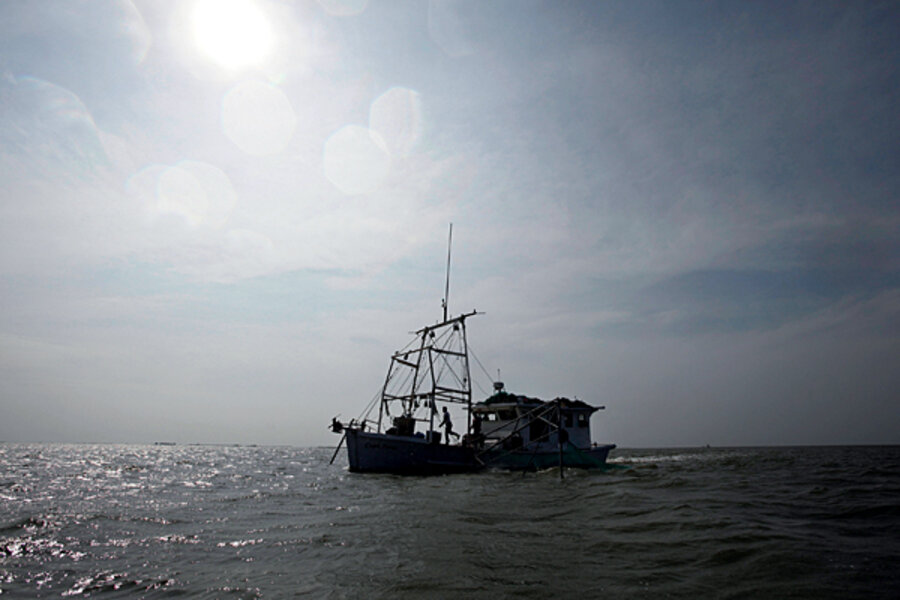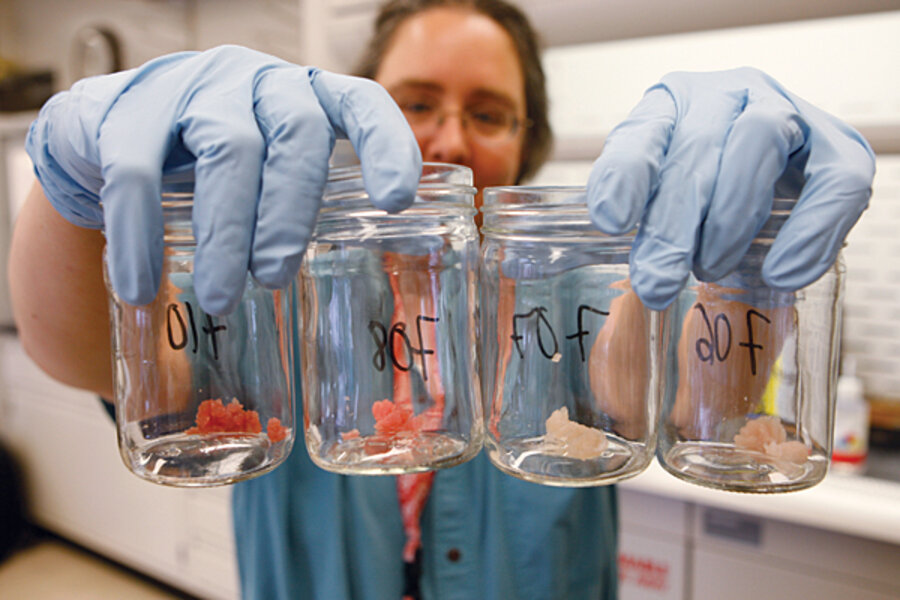Gulf oil spill: Can region keep its seafood on America's dinner tables?
Loading...
| Atlanta
Gulf shrimp-boat captains from Louisiana to Florida aren't finding anything wrong with their catch as they motor into waters reopened after this summer's oil spill off the Louisiana coast.
A small army of government testers, utilizing sniff, taste, and chemical tests for lingering toxic hydrocarbons, haven't found anything wrong with freshly caught grouper, speckled trout, and shrimp. The best New Orleans chefs are on TV ticking off the cornucopia of Gulf sea life that's good to eat.
But ask Jan Weddle Buffum of Maine if she's keen on the Gulf's seafood and the answer is more than a no. "I hope I am NOT eating anything from the Gulf!" she responded to a Monitor reporter's Facebook query. "I ask whenever I buy seafood."
In a normal year, the Gulf supplies the majority of domestic shrimp and oysters to American dinner tables, equaling about 2 percent of the total seafood consumed in the United States. For the Gulf states, $10.5 billion of gross domestic product is tied to the fishing industry, a number that could be halved this year by the 200-million-gallon oil spill that closed a third of the Gulf's critical fishing grounds.
Now the Gulf fishing business faces a big question: Can it overcome the same kinds of tainted food scandals that have hit the peanut, tomato, spinach, and egg industries in recent years – or will lingering suspicion further hobble the historic, but ailing, fishery?
"There is still purchasing loyalty toward buying Gulf Coast shrimp, but that purchasing loyalty is weakening," warned John Lambert, a consumer-behavior expert at Southern Mississippi University, after an August consumer survey.
About 43,000 square miles of the Gulf's nearly 300,000-square-mile fishing area remain closed because of the spill. But as 5,100 square miles of prime shrimping grounds reopened in early September, the market reflected hedged bets on whether consumers will bite.
The most recent statistics show Gulf shrimp selling for $1.50 a pound at the dock – half of what shrimpers were getting in late June. "Gulf shrimp demand is listed as down, and pricing continues to move downward," reported FAB Inc., a national food-buying cooperative, on Sept. 10.
Fishermen face a five-year climb or longer to restore the reputation of their catch, says Ashley Roth, a spokeswoman for the Louisiana Seafood and Marketing Board.
Alaskan fishermen said it took 10 years for them to rebuild the image of Alaskan seafood after 1989's Exxon Valdez spill in Prince William Sound, even though the vast majority of the fishery was unaffected.
But unlike other recent tainted-food scandals, the Gulf fishing industry is taking a beating based more on fear than fact, say food-safety experts. No evidence of taint from the spill has yet been found amid more than 2,000 samples taken.
US Food and Drug Administration guidelines for toxicity take into account an adult eating three pounds of fish per month, and about 1.6 pounds total of shrimp, crabs, and oysters. The FDA figures only about 10 percent of seafood-eaters consume that much per month. Moreover, experts say contamination that's significant enough to hurt someone would be noticeable to most alert consumers. (Think oily shrimp.)
"This is a great example of where one bad apple can destroy all the confidence," says Walt Dickhoff, who oversees the chemical testing now being done at random on Gulf seafood samples. "And that's why we're very conservative about [reopening fishing grounds]. Everything has to pass. If there's one fish out of the hundreds sampled for an area that fails, then the entire area fails."
While much of the oil from the spill has dissipated, scientists are still finding lots of it, including a swath that has settled on the Gulf bottom.
The decision to open the 5,100 square miles in early September was based on 73 individual shrimp samples taken from an area the size of Connecticut, noted Gina Solomon, a member of the Environmental Protection Agency's scientific advisory board, on the National Resource Defense Council website. "Does that reassure you that they've really found whatever contamination might be out there?" she asks.
In August, even some shrimp-boat captains protested the reopening of the federal waters, saying the government isn't testing enough samples across a wide enough area to allay public suspicion.
The Gulf fishery can scarcely afford to take the hit. Louisiana alone has seen its population of commercial fishermen halved since 1987, to fewer than 13,000, largely as a result of cheaper imported seafood grabbing market share. The spill could accelerate that trend. Meanwhile, fishermen are faced with having to negotiate long-term losses with Robert Feinberg, the administrator of a $20 billion BP escrow account, in order to stay afloat until consumer confidence rebounds.
Moreover, because of their independent nature and fractured industry, fishermen have weak trade associations compared with those of other agricultural products such as spinach and peanuts, leaving them less able to respond to failing consumer confidence. That has to change, many say.
"We're going to have to advertise and use some spokesman that people trust to get out there to say, 'The product is safe, there's nothing wrong with it,' " says Greg Ladnier, president of Sea Pearl Seafood in Bayou La Batre, Ala.
The White House is trying to help. President Obama has served fresh Gulf seafood at the White House. And in mid-September, White House chef Cris Comerford traveled to New Orleans for a block party thrown by some of the Big Easy's top chefs, featuring the best – and presumably safest – seafood even an oil-haunted Gulf of Mexico has to offer.






